You are here: Home | My Lindbergh Story | LINDBERGH IN MEXICO
By Juan A. Jose
LINDBERGH IN MEXICO
By Juan A. Jose
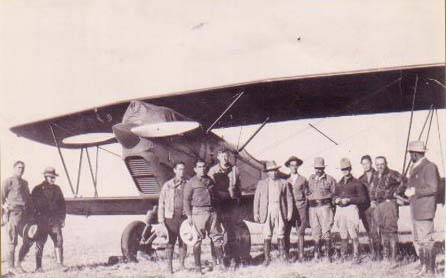
Lindbergh with mexican aviation hero Roberto Fierro among others in front of the Curtiss Falcon plane he flew to Mexico in 1928.
(Hector Davila archives)
Click on image to enlarge.
|
Juan A. Jose is currently the President of the
CAL/NX211 Collectors Society. He can be reached at
jajpcal@prodigy.net.mx
Charles A. Lindbergh parents visited the border city of Tijuana, Baja California, Mexico on their wedding trip in 1901. Charles first confirmed trip outside the U.S.A. was to Panama in 1913, when he traveled by boat with his mother to visit the building of the interoceanic way. There's no evidence supporting that Lindbergh visited Tijuana or any other mexican city during his stay in San Diego, while the "Spirit of St. Louis" was being built in the Spring of 1927, nor that he had flown over mexican territory during the test flights of the aircraft.
First time that Lindbergh flew over mexican territory was on September 23th, 1927, when he flew N-X-211 over Mexicali, Baja California en route from San Diego, CA to Tucson, AZ as a part of Lindbergh's succesful tour to promote aeronautics sponsored by The Guggenheim Fund. The second visit to mexican skies took place the next day, when he flew over Chihuahua state bound to El Paso, TX after taking of from Lordsburgh, NM. I haven't found any evidence to demonstrate that such short flights over mexican territory had been approved by mexican authorities, so it could be possible be that Lindbergh literally violated mexican air space!
Lindbergh's December 1927 nonstop flight between Washington D.C. and Mexico City (his first formal visit to my country) has its origin in the good personal relationship Lindbergh and his father in law to be; Dwight W. Morrow, established the moment they met at the temporary location of the White House in Washington D.C. on June 1927. Morrow claimed at then that the young aviator "had to be protected from the wolves", thus begining to act as some kind of mentor and advisor for Charles.
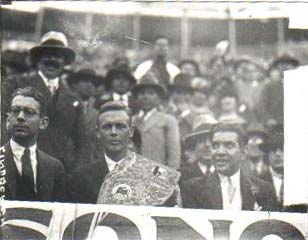
Lindbergh at "El Toreo" bullfiight ring in Mexico City in December 1927.
(AGN archives)
Click on image to enlarge.
|
Morrow was named US Ambassador in Mexico on August 1927. On September 29th 1927, Lindbergh wrote to his friend and financial guru, congratulating him for his new job and indicating that: "judging by the little I have been able to see in our borders, I'm afraid the job will be difficult" adding on the same letter- "if there's any opportunity where I can be of any help to you, please, call me". On October 4th answering to his congratulating letter, Morrow wrote to Lindbergh: "You talked to me once about the possibility of you making some flights in Latin America... it would be good to talk about it...". And so they did before Morrow left to Mexico by the end of October 1927. The Ambassador was right thinking Lindbergh's prestige could be well used on his mission in Mexico, through a "good will" flight that would help to relax a little the hostile atmosphere that prevailed on the bilateral relationships at that time. In the light of the positive reaction perceived in Mexico about a possible trip of Lindbergh to the country, barriers against the trip in the USA and elsewhere began to fall down and good reasons were found to make out of the Mexico visit the focal point of a Latin America tour. By the end of November two important events coincided to avoid an undefined delay of the flight: One of them was the US government's intentions to use aviation as a tool of the diplomacy (remember Pan American!), the other was the extraordinary success Morrow had on his diplomatic performance,so much that he quickly gained the confidence mexican president Plutarco Elias Calles. Lindbergh most probably had the intention of studying the possibilities of having an american company establishing one or more airlines flying to Mexico, Central and South America before any other country did it, thus adding pressure over the security of the Panama Canal, as the german owned colombian airline SCADTA had from the South. On the light of the above there has been especulation on who payed for Lindbergh's 1927-1928 Latinamerican trip expenses. Lindbergh claims that he payed all those expenses himself and not any airline or government, knowing Lindy as we do, we must accept that he payed for the trip, but maybe not for the quesadillas he ate in Mexico!
Mexican President Calles, was very happy with the idea of having Lindbergh as a guest and sent him a message in early December, not only inviting him to visit our country, but also promising a very warm welcome."Leave the problems of the flight to me...", Lindbergh told Morrow, who was not very happy about the aviator's desire of making the flight nonstop. As usual Lindbergh wanted to get more positive attention to the real capabilities of aviation and air mail reaching his destination on time, regardless of weather conditions or other limitations.
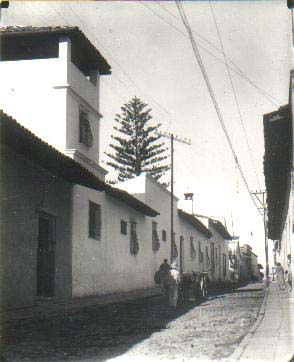
The Morrows Cuernavaca, Mexico "Casa Mañana" house in 1929.
(AGN archives)
Click on image to enlarge.
|
N-X-211 took of from Bolling Field in Washington, D.C. at 12:25 p.m. eastern standard time, on December 13th, 1927, arriving to Balbuena Field in Mexico City at 3:40 p.m. EST of the 14th. Several sources report the arrival at 2:39 p.m. Mexico time. According to Lindbergh the flight took a total of 27 hours and 15 minutes. While on the route, he kept his direction until he flew over Tampico, Tamaulipas, which he identified by the oil tanks. Then, something went wrong that caused an one hour and fifteen minutes delay on the estimated duration of the flight: For those awaiting him in Balbuena the delay was dramatic, and these included the President Calles, Ambassador Morrow, diplomats and thousands of people who attended the arrival. Comedian Will Rogers who was visiting Mexico calculated the crowd at the airfield on the 200,000 range. A worried Calles was quoted saying to Morrow: "If he crashed on the way, it would be the worst calamity falling over Mexico". There were fears about the impact that an accident of Lindbergh on this trip, would cause over the development of internactional aviation. It shouldn't be forgotten that in the Mexico of 1927, echoes of the Revolution could still be heard, and that the forced landing or accident of a pilot, even more of a foreigner one, and specially a "gringo" could be something very serious, and even worse if it was about the most famous man in the world. By the way, Amelia Earhart had to make an unscheduled landing in the State of Hidalgo, Mexico while trying to fly nonstop between Burbank, California and Mexico City on April 19th, 1935. Fourtunatly nothing happened to her. While waiting of the "Spirit of St. Louis" at Balbuena, a Cia. Mexicana de Aviación Fairchild airliner that had left Tampico a little before Lindbergh flew overthere, appeared on the horizon and was taken as the "Spirit" producing a short lasting excitement among the crowd.
Lindbergh ended up flying over the city of Toluca, where he finally located his posicion and headed towards the Valley of Mexico. Around two o'clock in the afternoon, it was officially anounced in Balbuena that he had been seen over Toluca and orders were given to the 9th Air Squadron pilots to take off and meet him. A Morane Saulnier M.S. 35, registration number 31ª fown by Major Agustín Castrejón, found N-X-211 and excorted it to Mexico City. About his detour and delay, Lindbergh latter admitted that it was his fault and tells a peculiar anecdote: After clearing the bad weather area, he tried to guide himself by the maps of Mexico he had gotten in his country, but he couldn't get to locate correctly the references, nothing seemed to match between what he saw from the plane and what he read on the map. He tried to apply the technique of identifying the towns reading their names on the train stations. Unfortunately, all he saw on the mexican train stations were signs where the word "Caballeros" could be read. But there was not any town with that name on the aviator's map, when he saw that every station he inspectioned was called the same way, he realized that that name corresponded to a special place for men, call it restrooms!. Lindbergh continued to guide himself by geographic accidents until he saw a quite big city, where he could see a sign on a wal that read "Hotel Toluca", which allowed him to locate his position and head correctly towards the nation's capital.
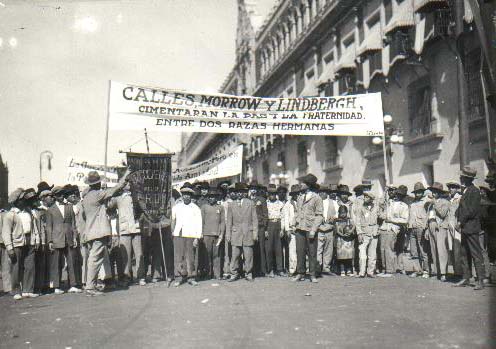
Labor workers and other union members showed their appreciation on Lindbergh's 1927 visit to Mexico.
(AGN archives)
Click on image to enlarge.
|
Once N-X-211 landed in Mexico City Morrow took Lindbergh to Calles who said: "I congratulate you on your trip, it's one more glory for your country, and a new glory for you", then he turned to Morrow and added "I have the pleasure to give you a safe and sound colonel Lindbergh, inside of my country's territory". Afterwards Mexico City Mayor gave Lindbergh the keys of the city, saying: "You can do here what you please". And so he did! because he got for himself and for his aviation causes the attention of the entire mexican population and its government. Calles declared to the press in Balbuena: "But this doesn't only have a technical interest as an heroic act of aviation... I consider it, above all, as a valuable embassy of good will that North America people is sending, who I'm sure that by sending us their highest representative of youth, will and heroism of the United States, did it to produce an spiritual and material get together even more strong between both countries. If I correctly translate the meaning of Lindbergh's trip, I can assure you that it's results, from the point of view I mean, will be and have already been more positive and immediate".
The trip between Balbuena and the United States Embassy where he was to stay took more than one hour, in which Lindbergh was acclaimed by thousands of mexicans. The same building is now a restaurant called "La Calesa de Londres", located on Londres street. Over the whole city, the sound of the "Viva Lindbergh!" was heard at the top of voices. On the capital's stores the flags of the United States and the recordings of it's anthem were sold out, the city was filled with pictures of Lindbergh and while the diplomatic differences were forgotten, at least for a while, mexicans began to give the name "Lindbergh" to food dishes, schools, theatres, drinks and anything ever imagined.
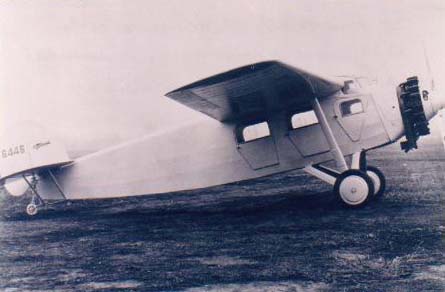
This Cessna CW-6 was flown in Mexico by Lindbergh 1929.
(Hector Davila archives)
Click on image to enlarge.
|
On December 15th, Lindbergh visited the Foreign Affairs Department and at the National Palace he was welcomed by Calles. On the evening he attended the gala session of Mexican Congress, where he was condecorated, he also saw the Aztec Calendar. On December 16th he visited the American School (that Constance Morrow attended) where he said to the students: "Boys, Aviation is the future way of transport between the United States and this country... when you grow up flights between both countries will be made through regular routes...". On that evening he went to Balbuena, where he made six flights over the Valley of Mexico on a Morane Saulnier plane, M.S. E.P.2 35, registration number 31A128, of the then mexican armed forces. The first flight he made it with Mayor Alberto Castrejón, then he took up among others Will Rogers. Lindbergh expressed his admiration for mexican pilots, Mexican pilots have to face not only the important elevation of the capital, but to the very changing winds and to the topography of the region -"I had never seen the wind change so fast"- Lindbergh said. On December 17th a Festival on the National Stadium was held on his honor. Over sixty thousand people filled up the seats. Lindbergh arrived to the Stadium with Calles and Morrow. That same day, the "Spirit of St. Louis" got the two mexican flags that were painted on its cowling. On December 18th, he attended a "jaripeo" at the Rancho del Charro, and he also attended a bullfight. At downtown an impressive workers parade was organized in his honor; 100,000 workers participated. Lindbergh witnessed the event from the balconies of the National Palace.
On the 19th he visited Xochimilco floating gardens South of Mexico City, then on the 20th, he performed a series of flights on a Cia. Mexicana de Aviación Fairchild FC-2, registration number M-SCOE. Among his passengers were the President Calles (on his first flight ever!), Mexican President to be General Alvaro Obregn and Dwight Morrow. "Who doesn't feel safe flying with Colonel Lindbergh!" said Calles after the flight. On the evening came the homage of the Mexican Army, during those ceremonies Lindbergh was asked for his oppinion about the Military School and he answered: "Fine, just fine..." (That's Lindy right!!!). Nevertheless, later that same day, Lindbergh had to make an effort to speak foretelling the future or air services between Mexico and the United Sates; he said he was convinced that the conditions where right to establish an airline between the United States and Mexico and he pretended to obtain the necessary support from both governments, businessmen and citizens.
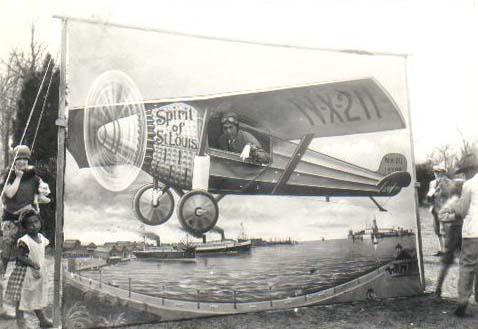
Mexican folklore celebrating Lindbergh's visit to Mexico in 1927.
(AGN archives)
Click on image to enlarge.
|
On December 21st, 1927 Anne Morrow arrived into Mexico City to spend Christmas with her family. That was the day Charles and Anne met and this special event took place at the US Embassy in Mexico City. The irony is that she was not very happy about the idea of the hero who was invading the family environment, so much that she even wrote on her diary that "she was not to reverence Lindy". Something the shy, little, cultivated and beautiful Anne, didn't count on, was destiny itself. On the 22nd and with Henry Ford's help, Mrs. Evangeline Lindbergh (mother) arrived in Mexico City flying on the biggest plane that had operated until then in Balbuena: a Ford Trimotor 4-AT-10, registration number NC-1077, Bill Sout was the pilot. Charles took of on the "Spirit of St. Louis" to the encounter of the "Ford" with no success. When he got back he had to make three small flights to avoid hurting anybody between the crowd who was waiting at the military airport. Before meeting his mother he had time that day to visit Teotihuacan Piramids. On the 23rd Lindbergh left to Cuernavaca, Morelos, with a group of military officers, including Emilio Carranza. Christmas eve took place in the intimacy of the Morrow family, embassy officers, some close guests of the family and Mrs. Lindbergh. On Christmas Day Lindbergh went back to Xochimilco with the Morrows and his mother, playing "unknown" with some success. At some point in this visit Lindbergh avoided an unpleasant experience when one of Morrow's friends was taken as if he was Lindbergh by a big mexican who hugged him and not noticing his mistake said to this person: "Adored hero, I can't let you go without hugging you!". On the 26th he flew the same Ford Trimotor that brought her mother to Mexico, among her passengers were members of the Morrow family including Mrs. Morrow, Elizabeth, Constance and Anne (first time on the air with Charles!).
He said goodbye to President Calles on the 27th and left for Guatemala City flying N-X-211on December 28th,. His Latinamerican Goodwill Tour ended in Saint-Louis, MO on February 13th after visiting Mexico, Guatemala, Belize, El Salvador, Honduras, Nicaragua, Costa Rica, Panama, Colombia, Venezuela, Virgin Islands, Puerto Rico, Domincan Republic, Haiti and Cuba.
While in Mexico Lindbergh had said that: "this will not be the last visit I make to Mexico since I am planning to come back in a few years", and yes he did and it didn't take him years but months to be back in my country for Anne was a good reason to make the trip back. In November 1928 he used a hunting expedition in the State of Chihuhua as a reason to fly South to Cuernavaca on a Curtiss Falcon registration number NC7455. The Morrows had felt in love with Cuernavaca (now a city only one hour away from Mexico City), so much that they had a home made to spend their weekends, their house was called "Casa Mañana". The story says that every time the Morrow's asked for the estimated date of completition of some job on the house, the person building it would say: "Mañana", meaning tomorrow!. The street where the house is located was named "Morrow street" houring a family that helped a lot rise the international prestige and cultural heritage of Cuernavaca. For example, Diego Rivera's murals at the Cortez Palace downtown Cuernavaca where a gift of Dwight Morrow. It has been reported that Mrs. Morrow long after her husband death used to go back to her house in Mexico to enjoy it and spend quiet and nice times there. Nowadays "Casa Mañana" remains much in the same condition Mrs Morrow left it but it is now a mexican food restaurant called "La India Bonita".
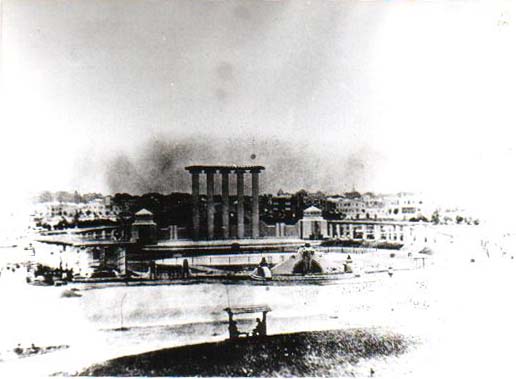
A 1927 picture of Colonel Lindbergh Theatre at San Martin Park (Now Mexico Park) in Mexico City.
(Juan A. José Archives)
Click on image to enlarge.
|
Lindbergh returned to Mexico in February 1929 during a Pan American inaugural flight to Cristobal , Canal Zone, Panama (FAM-5), this time he flew a Sikorsky S-38 flying boat registration NC8000 making stops in the mexican Caribbean coast (among them Cozumel in the Yucatan peninsula). Also in February (on the 12th) Ambassador Morrow announced at the Embassy in Mexico City "the formal engagement of their daughter Anne Spencer Morrow to Colonel Charles A.Lindbergh", then on the 24th the groom returned to Mexico City flying a Travel Air 6000B registration NR8139. This particular airplane will later be known as "Miss Wichita" and "Romancer", this last name apparently in honor of Charles and Anne. On this same aircraft Charles and Anne took of from Balbuena on February 27th for a little picknic trip. On take of back to Mexico City the plane lost a wheel, the plane had no seat belts so Charles helped Anne cover herself with seat cushions. After using all the fuel Lindbergh succesfully crash landed the plane on the one wheel left. The aircraft ended up-side down, Anne was not hurt but Charles hurt again his right shoulder (the same one he had dislocated after he bailed out of a plane he was testing in Saint Louis back in May 1925). The day after this accident Charles flew a mexican Fleet biplane. During this visit to Mexico Lindbergh also evaluated o behalf of Mexican Armed Forces the potential military use of a Cessna CW-6 plane (registration 6446). Around this time Lindbergh made a comment regarding air power in Mexico: "Whoever controls the air controls Mexico". Lindbergh's 1929 visits to my country had a high note when he agreed to be in command of Cia. Mexicana de Aviación's inaugural flight on their first international route: Mexico-Tampico-Brownsville (F.A.M.8). The aircraft used was a Ford Trimotor 5-AT-B-12 named "Mexico" with mexican registration M-SCAN and US registration 9661. This flight took place March 9th. Flight back to Mexico City with Lindbergh also in command of the "Mexico" took place next day and among the personalities onboard were Juan and Betty Trippe.
On September 29th, 1929 the Lindbergh's and the Trippes began a Southamerican and Caribbean tour in one of Pan American's Sikorsky's S-38's (NC9137) inaugurating F.A.M. 6 to Surinam from Puerto Rico. The group reached Cozumel, Mexico on the first days of October. While the Trippes continued their way towards Cuba the Lindgerghs stayed in the Yucatan area searching for piramids with Carnegie Institute's Dr. Ricketson and arqueologist Alfred Kidder. The Lindberghs flew over and visited arqueological sites the mexican states of Campeche, Yucatan and what's now Quintana Roo. A controversy arised when Lindbergh was credited somehow the discovery of a Mayan lost city, a discovery that in reality never took place. In this case (as usual), some people tried to capitalize on Lindbergh's fame and did the aviator a bad favor among arqueologists.
I have not found (and I will really appreciate any help from fellow members) any evidence showing that Lindbergh came back to Mexico after his arqueological expedition until the mid 1960's. In the mean time the Lindbergh's had a very close encounter in París, France in 1939 with mexican culture when they ran into the very famous mexican painter Frida Kahlo (wife of Diego Riviera) and who was wearing a colourfull "tehuana" dress that impressed Anne a lot. Charles and Anne visited Baja California on a grey whale watching expedition organized by their son Jon in 1967. Land and other family members were on the same trip. It is reported that Charles gave them a big scare when he jumped of the boat to swim with the whales!
Sometime in 1968 two airline pilots belonging to Aeronaves de México (now Aeromexico) were enjoying a relaxing time near the city of La Paz, in Sourthern Baja California when they saw an anphibian plane land nearby, the curious pilots approached to the plane that turned out to be a Grumman Goose G-21, registration N3222 just to find that Lindbergh was onboard along with California Academy of Sciences Dr. Lindsey performing another whale protection effort. To their surprise (and I think to the surprise of every member of our collectors society) Lindbergh spent the day with these mexican airman, skindived, fished and ate with them, he even allowed them to have their picture taken with him!
Last evidenced news of what may be Lindbergh's visit to Mexico indicate that Charles returned to Mexico City in 1972 where he gave an interview to a mexican journalist (another surprise!) and met with mexican officials trying to protect the grey whale of Baja California. I am sure Charles may have visited or passed by Mexico City many other times on one of those supervision trips he made as a member of the board of Pan American, specially in the50's 60's and the early 70's.
The "Lone Eagle" visits have left many landmarks in Mexico: A big and beautiful open air theatre was named "Teatro Coronel Lindbergh" on January 10th, 1928. Lindbergh is among those that mexican muralist Juan O'Gorman portrays in his 1938 mural called: "The Conquest of Air". This mural is still at Mexico City Airport. At the same airport there's a 1961 Lindbergh bust by artist Ernesto Tamaríz. There is also a Charles Augusts Lindbergh street in Mexico City and at least one school here carries the Lindbergh name. The former site where the American School in Mexico City was located when he visited it in December 1927 became a school called Charles Lindbergh, because of Charles controversial stands during WWII his name was taken out of the building that remains being used as a public school. On the Mexico City Technology Museum there is a well made and well preserved scaled down replica of the "Spirit" on display.
Reprinted with permission of Juan A. Jose, Copyright 2000
View additional photo's of
Charles Lindbergh in Mexico (1927-28).









